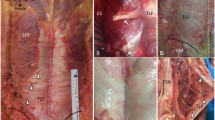Abstract
There is significant paucity in the literature regarding vertebral aponeurosis. We were able to find only a few descriptions of this specific fascia in the extant medical literature. To elucidate further the anatomy of this structure, forty adult human cadavers were dissected. Both quantitation and anatomical observations were made of the vertebral aponeurosis. The vertebral aponeurosis was identified in 100% of specimens. This fascia was identified as a thin fibrous layer consisting of longitudinal and transverse connective tissue fibers blended together deep to the latissimus dorsi muscle. It attached medially to the spinous processes of the of the thoracic vertebrae; laterally to the angles of ribs; inferiorly to the fascia covering the serratus posterior inferior muscle (superficial lamina of the posterior layer of thoracolumbar fascia); superiorly it ran deep to the serratus posterior superior and splenius capitis muscles to blend with the deep fascia of the neck. At the level of the serratus posterior inferior muscle, the vertebral aponeurosis fused to form a continuous layer descending toward the sacrotuberous ligament covering the erector spinae muscle. Morphometrically, the mean length of the vertebral aponeurosis was 38 cm and the mean width was 24 cm. The mean thickness was three mm. There was no significant difference between left and right sides, gender or age with regard to vertebral aponeurosis length, width, or thickness (P > 0.05). During manual tension of the vertebral aponeurosis, the tensile force necessary for failure had a mean of 38.7 N. In all specimens, the vertebral aponeurosis was capable of holding sutures placed through its substance. We hope that these data will be of use for descriptive purposes and may potentially add to our understanding of the biomechanics involved in movements of the back. As back pain is perhaps the most common reason patients visit their physicians, additional knowledge of this anatomical region is important.





Similar content being viewed by others
References
Barker PJ, Briggs CA (1999) Attachments of the posterior layer of the lumbar fascia. Spine 24:1757–1764
Barker PJ, Guggenheimer KT, Grkovic I, Briggs CA, Jones DC, Thomas CD, Meng CDL, Hodges PW (2006) Effects of tensioning the lumbar fasciae on segmental stiffness during flexion and extension. Spine 4:397–405
Barker PJ, Briggs CA (2004) The lumbar fasciae and segmental control. In: Boyling JD, Jull GA (eds) Grieve’s modern manual therapy: the vertebral column. Churchill Livingstone, Edinburgh, pp 141–153
Bogduk N, Macintosh JE (1984) The applied anatomy of the thoracolumbar fascia. Spine 9:164–170
Bogduk N, Twomey LT (1987) Clinical anatomy of the lumbar spine. Churchill Livingstone, Melbourne
Carr D, Gilbertson L, Frymoyer J, Krag M, Pope M (1985) Lumbar paraspinal compartment syndrome: a case report with physiologic and anatomic studies. Spine 10:816–20
Clemente C (1984) In grays anatomy, fasciae and muscles of the trunk. 30th edn, Williams & Wilkins, Baltimore, pp 465–466
Faraj AA, Mehdan H (1997) Thoracolumbar hernia: a rare case of back pain. Eur Spine J 6:203–204
Holden L (1885) Holden’s anatomy. 5th edn, Blakiston, Son & Co, Philadephia, pp 298
Hollinshead HW (1982) Anatomy for surgeons Vol 3. 3rd ed, Harper and Row, Philadelphia, pp 151–152
Konno S, Kikuchi S, Nagaosa Y (1994) The relationship between intramuscular pressure of the paraspinal muscles and low back pain. Spine 19:2186–9
Macintosh JE, Bogduk N (1986) The biomechanics of the human multifidus. Clin Biomech 1:205–213
Panjabi M (1992) The stabilizing system of the spine: part I. function, dysfunction, adaptation, and enhancement. J Spinal Disord 5:383–9
Pick PT, Howden R (1977) Grays anatomy: the muscles and fasciae. 19th American edn, Bounty Books, New York, pp 341–342
Raffoul W, Dusmet M, Landry M, Ris HB (2001) A novel technique for the reconstruction of infected full-thickness chest wall defects. Ann Thorac Surg 72:1720–1724
Skandalakis JE, Colborn GL, Weidman TA, Foster RS, Kingsnorth AN, Skandalakis LJ, Skandalakis PN, Mirilas PS (2004) Surgical anatomy. abdominal wall and hernias. Paschalidis Medical Publishers, Athens, pp 457–458
Standring S (2005) Grays anatomy, 39th edn, Chapter 45 The back. Elsevier Churchill Livingstone, Edinburgh, pp 734–735
Toldt C (1928) An atlas of human anatomy. Macmillan, New York, pp 267
Tubbs RS, Kelly DR, Humphrey ER, Chua GD, Shoja MM, Salter EG, Acakpo-Satchivi L, Wellons JC III, Blount JP, Oakes WJ (2006) The tectorial membrane: anatomical, biomechanical, and histological analysis. Clin Anat 20:382–386
Tubbs RS, Oakes WJ (2006) A simple method to deter retethering in patients with spinal dysraphism. Childs Nerv Syst 22:715–716
Vilensky JA, Baltes M, Weikel L, Fortin JD, Fourie LJ (2001) Serratus posterior muscles: anatomy, clinical relevance, and function. Clin Anat 14:237–241
Vleeming A, Pool-Goodzwaard AL, Stoechart R, van Wingerden JP, Snijders CJ (1995) The posterior layer of the thoracolumbar fascia. Spine 20:753–758
Yahia LH, Rhalmi S, Newman N, Isler M (1992) Sensory innervation of human thoracolumbar fascia: an immunohistochemical study. Acta Orthop Scand 63:195–7
Author information
Authors and Affiliations
Corresponding author
Rights and permissions
About this article
Cite this article
Loukas, M., Shoja, M.M., Thurston, T. et al. Anatomy and biomechanics of the vertebral aponeurosis part of the posterior layer of the thoracolumbar fascia. Surg Radiol Anat 30, 125–129 (2008). https://doi.org/10.1007/s00276-007-0291-4
Received:
Accepted:
Published:
Issue Date:
DOI: https://doi.org/10.1007/s00276-007-0291-4




